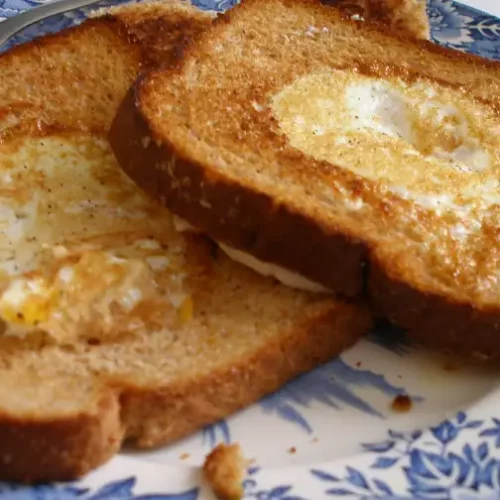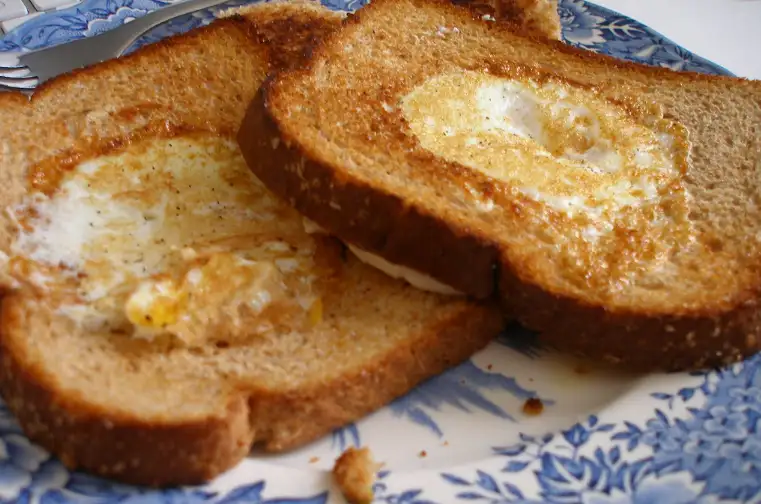Before: Breakfast can often be a mundane routine, but there’s a dish that promises a delightful twist on the classic combo of eggs and toast.
After: Imagine a single dish that effortlessly combines the savory richness of fried eggs with the crispy satisfaction of toast—a breakfast experience like no other.
Bridge: Enter hobo eggs, a beloved recipe known by names like “egg in a basket” and “one-eyed Jack.” Let’s dive into its simple preparation, intriguing history, and countless ways to make it your own.

The Recipe: How to Make Hobo Eggs
Ingredients
- 1 thick slice of bread your choice of bread: regular, artisan, gluten-free, or keto-friendly
- 1 tablespoon butter or substitute with olive oil, vegetable oil, or pan spray
- 1 large egg
- Salt and pepper to taste
- Optional: Fresh herbs like parsley smoked paprika, shredded cheese, or any additional seasonings you enjoy.
Instructions
- Use a glass, cookie cutter, or knife to cut a circular hole (about 2.5-3 inches across) in the center of the bread slice. Set both the slice and the cut-out aside.
- Heat a nonstick or cast-iron pan over medium heat, or place it over indirect heat on a campfire. Melt the butter, seasoning it with spices like smoked paprika if desired.
- Place the bread slice and cut-out in the pan. Lightly toast each side for about a minute.
- Crack the egg into the hole in the bread, ensuring the yolk stays centered. Season with salt and pepper.
- Cook for 2-3 minutes, allowing the egg white to set. Then, carefully flip the bread and egg to cook the other side for an additional 20-30 seconds (or longer, depending on your preferred yolk consistency).
- Optional: Sprinkle shredded cheese over the egg and bread after flipping, and cover the pan to melt the cheese.
- Serve immediately, garnished with fresh herbs if desired, and enjoy the toasted cut-out as a dipper.
A Dish with a Mysterious History
The origin of hobo eggs dates back to at least the late 19th century. The first recorded recipe appeared in Fannie Farmer’s The Boston Cooking-School Cookbook in 1896 under the name “eggs in a hat.” Farmer’s version involved a pre-fried egg placed atop a toasted bread circle, differing slightly from today’s method of cooking the egg directly in the bread.
As the dish evolved, it acquired many names inspired by popular culture, such as “Guy Kibbee eggs” from the 1935 film Mary Jane’s Pa and “gashouse eggs” from the 1941 musical Moon Over Miami. It has also appeared in films like V for Vendetta and TV shows like Friends, where it was humorously dubbed “eggs a la Eddie.”
Why the Name “Hobo Eggs”?
The term “hobo” originally referred to traveling workers in the late 19th and early 20th centuries. Hobos often cooked simple, resourceful meals over campfires during their journeys. While the exact link between hobos and this egg-in-toast recipe remains unclear, it’s easy to imagine its appeal as a quick and filling dish for someone on the move. However, it’s worth noting that “hobo” can be considered a derogatory term today, prompting many to use alternative names for this beloved breakfast.
Customization and Tips
Take your egg cooking skills from simple hobo eggs to the more elaborate deviled scotch eggs.
One of the best aspects of hobo eggs is how adaptable they are. Here are some creative variations:
- Spiced Butter: Infuse the butter with smoked paprika, cumin, or dried herbs before cooking.
- Cheesy Upgrade: Sprinkle cheese over the egg and bread after flipping and cover the pan to let it melt.
- Bacon Fat: Use rendered bacon fat instead of butter for extra flavor.
- Vegetarian Options: Add sautéed onions, bell peppers, or mushrooms as toppings.
- Gluten-Free or Keto-Friendly: Use gluten-free or low-carb bread to suit dietary needs.
Serve your hobo eggs with sides like grits, hash browns, fresh fruit, or a cup of coffee for a complete breakfast.
Conclusion
Hobo eggs, no matter what you call them, are a testament to the beauty of simple cooking. Whether you’re making them at home or over a campfire, this dish offers endless opportunities for customization and deliciousness. Why not try making your own version today and create new memories around this timeless breakfast classic?

